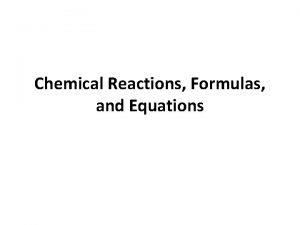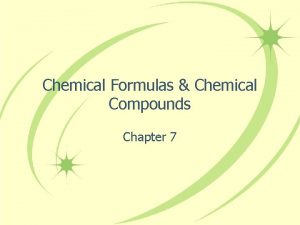CHAPTER 17 CHEMICAL REACTIONS Section 1 Chemical Formulas












- Slides: 12

CHAPTER 17: CHEMICAL REACTIONS Section 1: Chemical Formulas and Equations

A. Matter can change physically or chemically; a process that produces a chemical change is a chemical reaction. Physical change Chemical change

B. A chemical equation is a shorthand form of what reactants are used and what products are formed in a chemical reaction.

1. Some equations use words or chemical names to identify reactants and products.

2. Chemical formulas represent chemical names of substances in a chemical equation.

C. The mass of reactants and mass of products in a chemical reaction is always the same due to the law of conservation of mass.

D. Chemical equations are balanced when the number of atoms is the same on each side of the equation.


E. Energy is released or absorbed during a chemical reaction. 1. When reactions release energy (exothermic reactions), the products have bonds with less energy than those of the reactants. Ex: burning coal C + O 2 CO 2 + heat

2. When reactions absorb energy (endothermic reactions), the reactants are more stable and their bonds have less energy than those of the products.


3. Heat energy may be absorbed or released; the rate of heat release can be rapid or slow 4. The word energy can be written in a chemical equation as a reactant or a product.
 Section 2 reinforcement classifying chemical reactions
Section 2 reinforcement classifying chemical reactions Chemical reactions section 2 classifying chemical reactions
Chemical reactions section 2 classifying chemical reactions Chemical reactions section 3 reactions in aqueous solutions
Chemical reactions section 3 reactions in aqueous solutions Chemical reactions section 1 chemical changes
Chemical reactions section 1 chemical changes Chapter 18 chemical reactions balancing chemical equations
Chapter 18 chemical reactions balancing chemical equations Chapter 8 review chemical equations and reactions section 2
Chapter 8 review chemical equations and reactions section 2 Chapter 8 section 1 chemical equations and reactions
Chapter 8 section 1 chemical equations and reactions Empirical formula and molecular formula pogil
Empirical formula and molecular formula pogil Love chemical formula
Love chemical formula Chapter 10 chapter assessment chemical reactions answers
Chapter 10 chapter assessment chemical reactions answers Chapter 9 study guide chemical reactions
Chapter 9 study guide chemical reactions Dichlorine octoxide formula
Dichlorine octoxide formula Combination reaction example
Combination reaction example























